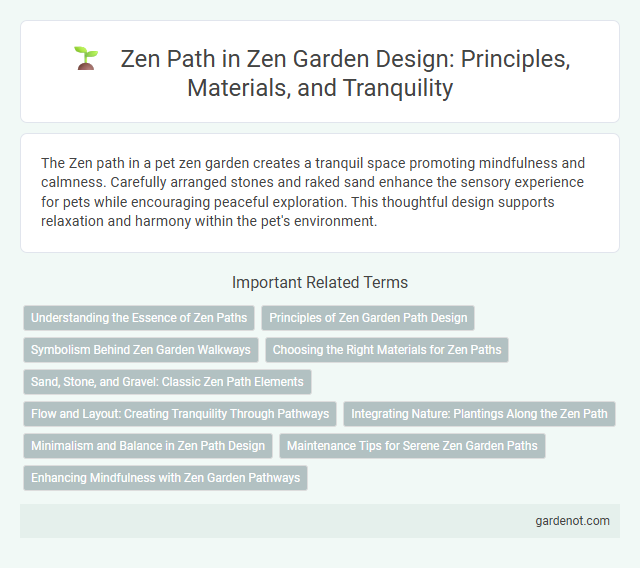The Zen path in a pet zen garden creates a tranquil space promoting mindfulness and calmness. Carefully arranged stones and raked sand enhance the sensory experience for pets while encouraging peaceful exploration. This thoughtful design supports relaxation and harmony within the pet's environment.
Understanding the Essence of Zen Paths
Zen paths embody simplicity and mindfulness, guiding practitioners through carefully arranged stones and gravel that symbolize natural elements and life's journey. Each step on the path encourages introspection and a deep connection with the present moment, fostering inner peace and clarity. The deliberate design of Zen paths reflects the core principles of Zen Buddhism, emphasizing harmony, balance, and the essence of existence.
Principles of Zen Garden Path Design
Zen garden path design emphasizes simplicity, natural materials, and mindful placement to create a tranquil and contemplative atmosphere. Paths often follow irregular, flowing patterns that encourage slow, deliberate walking and reflection, embodying the Zen principles of harmony and balance. Using stone, gravel, and moss, designers create textures and contrasts that enhance sensory experience while maintaining minimalism and spiritual focus.
Symbolism Behind Zen Garden Walkways
Zen garden walkways symbolize the journey toward enlightenment, guiding visitors through carefully arranged stones and gravel patterns that represent the flow of life and nature's rhythms. The deliberate placement of each step encourages mindfulness, reflection, and a deeper connection to the present moment. These paths embody the balance between simplicity and complexity, embodying Zen principles in physical form.
Choosing the Right Materials for Zen Paths
Selecting the right materials for Zen paths is essential to achieving harmony and tranquility in the garden. Natural elements such as smooth river stones, gravel, and weathered wood enhance the tactile experience while promoting mindfulness during walking. These materials should be chosen for their texture, durability, and symbolic significance to complement the minimalist aesthetics of a traditional Zen garden.
Sand, Stone, and Gravel: Classic Zen Path Elements
Sand, stone, and gravel form the essential elements of a classic Zen garden path, embodying simplicity and tranquility. Smooth sand symbolizes water and flows gently around carefully placed stones representing islands or mountains, guiding mindful walking. Gravel adds texture and sound, enhancing sensory engagement and promoting meditation as one traverses the pathway.
Flow and Layout: Creating Tranquility Through Pathways
Zen garden pathways are designed with deliberate flow and layout to cultivate tranquility and mindfulness. Curved lines and natural materials guide movement, encouraging contemplation and a slow, meditative pace. Strategic placement of stones and plants enhances balance and harmony, creating a seamless connection between nature and space.
Integrating Nature: Plantings Along the Zen Path
Plantings along the Zen path emphasize natural harmony by carefully selecting native and seasonal plants that enhance tranquility and mindfulness. Moss, ferns, and bamboo are commonly integrated to create textured layers and evoke a serene atmosphere. Thoughtful placement of stones and greenery guides visitors through a meditative journey, fostering deep connection with nature.
Minimalism and Balance in Zen Path Design
Zen path design emphasizes minimalism and balance by integrating natural materials and simple, flowing lines that promote tranquility and mindfulness. Carefully placed stones and gravel patterns guide movement while maintaining harmony with the surrounding landscape, embodying the essence of Zen philosophy. This minimalist approach enhances spatial awareness and encourages contemplative walking, fostering inner peace and connection with nature.
Maintenance Tips for Serene Zen Garden Paths
Regularly raking Zen garden paths removes debris and maintains the harmonious ripple patterns essential for tranquility. Use a soft broom to gently clear leaves and dirt without disrupting the carefully arranged gravel or sand. Periodic replenishment of gravel helps preserve the path's texture and aesthetic, ensuring a consistently serene environment.
Enhancing Mindfulness with Zen Garden Pathways
Zen garden pathways enhance mindfulness by guiding focused walking and deliberate movement through the space, encouraging deep awareness of each step and breath. The carefully arranged stones and raked gravel patterns foster a meditative state, allowing the mind to settle and connect with the present moment. Walking along these paths cultivates a rhythm of calmness and introspection, integral to the Zen garden experience.
Zen path Infographic

 gardenot.com
gardenot.com